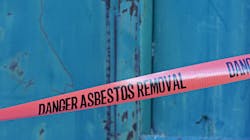What does the Toxic Substances Control Act do?
The Toxic Substance Control Act (TSCA) regulates certain substances (chemicals and microorganism) to protect public health and the environment. This act is found in 15 USC 53 §2601 et seq and in CFR Title 40 Chapter 1 subchapter R Parts 700-799. It authorizes the EPA to enforce reporting and record-keeping, premanufacture notification (PMN), and other regulations for certain substances listed in the TSCA Inventory.
The chemicals regulated by the TSCA include polychlorinated biphenyls (PCBs), asbestos, certain benzene-containing chemicals, and some of the per- and polyfluorinated alkyl substances (PFAS). PFAS included in the TSCA inventory include salts of perfluorohexane and perfluoroheptane sulfonates. Pseudomonas sp., and Mycobacterium sp. are among the microorganisms in this inventory.
Specific features of the TSCA
The following are the four key features of the TSCA:
- It has a broad jurisdictional reach as it not only covers a broad range of chemicals, it also regulates the manufacturing of these chemicals.
- It provides authority to the EPA to provide testing protocols on certain chemicals in certain situations to assess for their potential harmful effects on public health and the environment. These situations include when there is insufficient data and it is necessary to develop the data to determine the harmful effects of the chemical. There are several programs that the EPA collaborate with for the testing of the chemicals and these include the high production volume (HPV) Challenge Program and the Chemical Assessment and Management Program (ChAMP). Chemicals produced in high quantities are screened by the EPA using ChAMP and the information from this screening for the chemical(s) of concern is used by the manufacturer(s) who voluntarily develop basic chemical toxicity data.
- It requires the submission of a PMN from the manufacturer of a new chemical for a proposed new significant use.
- It provided the EPA with a broad range of enforcement options to regulate the chemicals that the EPA considers or predicts as a risk to human health and the environment. These options range from mild to strict – requiring manufacturers to retain records of the chemical of concern, warning or other notifications to the manufacturer(s), limiting the production quantity of the chemical, or prohibiting the manufacturer(s) from manufacturing the chemical of concern. According to section 6 of the TSCA, the EPA should use the least burdensome of its options. However, this section also specifies that unless the EPA determines that it is in the public interest to regulate the chemical of concern under the TSCA, it should not use the TSCA if the risk of the chemical can be addressed under another law.
All of the above key features of the TSCA point to one goal: to protect public health and the environment through EPA authority to regulate the substance of concern by addressing its testing, premanufacture, and other regulations in section 6 (in part 751).
What Impact Does the TSCA Have on Water & Wastewater Utilities?
The TSCA protects our water supplies by regulating substances that could pose risk to public health and the environment. Specifically, water and wastewater utilities are protected from the risk of the toxic substances due to the regulations manufacturers, importers, and distributors must comply with, under the TSCA.
There is non-existence or low prevalence of chemicals such as PCBs, some of the PFAS, asbestos, lead-based paints, methylene chloride, and mercury-containing compounds in water supplies as these are regulated by the TSCA.
What Impact Does the TSCA Have on Industrial Facilities & Manufacturers?
Industrial facilities and manufacturers need to comply with the PMNs, SNURs, testing requirements, record-keeping, and reporting to the EPA, when applicable under the TSCA.
Nevertheless, these compliance activities not only assist them to understand the substance they are dealing with – specifically the toxic risk and the environmental effect of the substance — but they also provide them with the opportunity to produce new substances that are less toxic than the existing ones.
History of the TSCA
According to the report by the Council on Environmental Quality (CEQ), released in 1971, toxic chemicals were getting in the environment and new legal authorities to regulate these chemicals were required as the existing authorities were considered inadequate. This led to the concerns about the health and the environmental risks of these toxic chemicals and also that there was no legal mechanism to impede the introduction of the “next-generation” toxic substances.
Since its enactment in 1976, the TSCA has not only added substances of concern to its inventory, it has also strengthened regulations for toxic and new substances – all for the purpose to protect the public health and the environment from the toxic effects of these substances.
The history of the TSCA includes addressing the regulations of specific chemicals of concern including for PCBs, asbestos, and radon.
PCBs
After the TSCA came into effect a year after its enactment, there was growing concerns about the health and the environmental effects of PCBs. This family of chemicals break down slowly in the environment and are suspected carcinogens in humans.
The EPA passed regulations in 1978 for the disposal of PCBs, specifically requiring that high-level PCB-containing wastes (i.e. wastes containing more than 500 part per million PCBs) can only be disposed of using EPA-approved incinerators under controlled conditions. However, this led to more concerns about managing these wastes as due to these regulations, there were millions of pounds of high level PCB- containing oil waste in storage and awaiting EPA approval.
Eventually in 1981, the EPA approved the first two disposal facilities, specifically high temperature incinerators, in the United States for safely destroying these PCB-containing wastes. Prior tests done showed that these high-temperature incinerators could not only destroy more than 99% of the PCB-containing oil wastes, they would also not threaten public and environmental health.
Asbestos & Radon
In 1982, the EPA announced a mandate requiring all public, private elementary, and secondary schools to identify any friable material (i.e. dry material that may crumble or be reduced to powder by hand pressure) containing asbestos used in their buildings.
Asbestos, a known human carcinogen, was widely used in materials for fire-proofing and acoustical insulation in buildings. Four years later, the Asbestos Hazard Emergency Response Act was signed. The purpose of this act was to protect students and others in schools from friable asbestos-containing material. Following another two years, the Indoor Radon Abatement Act was announced. Both of these acts are in Subchapter II and III, respectively, under the TSCA in 15 USC chapter 53.
Where the TSCA Stands Today: The Frank R. Lautenberg Chemical Safety for the 21st Century Act & the EPA’s activities
The major milestones since 2016 supporting the TSCA are summarized in Figure 1. These include the Frank R. Lautenberg Chemical Safety for the 21st Century Act (also known as the 2016 Lautenberg Act) signed into law in 2016. It has six major highlights:
- The EPA must establish a risk-based process to determine which chemicals, in addition to persistent, bioaccumulative and toxic (PBT) chemicals, to prioritize for assessment, identify them as high or low priority substances, and take the appropriate actions to address their unreasonable risk to public health.
- It evaluates the safety of new chemicals, or significant new use of an existing chemical should be done by the EPA before these chemicals are in the market.
- It requires the EPA to review all new confidentiality claims on chemicals.
- It allows the EPA to collect fees including from the submission of test data for review and from the PMN for a new chemical or use
- It preserved, including federal co-enforcement, state environmental regulations for waste disposal and treatment. The purpose of this is to create a federal-state partnership for regulating chemicals to protect public health and the environment.
- It created an Amendment to the Mercury Export Ban Act. This applies to nonoperational mercury-storage facilities. In addition to prohibiting the export of certain mercury compounds, it also requires the EPA to create an inventory on the supplies, uses, and trade of mercury compounds.
2019 Major TSCA Milestones
Two additional major milestones supporting the TSCA occurred in 2019: update to the TSCA Inventory and the methylene chloride ban. The updated inventory listed chemicals that are active and inactive in commerce in the U.S. and showed that more than 80% of the chemicals in commerce can be accessed by the public for more information.
The methylene chloride ban prohibited the manufacture, import, processing, and the use of methylene chloride for consumer paint and coating removal products after acute fatalities were reported from the exposure to methylene chloride from these products.
Additional EPA Activity
Besides the above, the EPA has also been actively involved since the 2016 Lautenberg Act in the following ways:
- August 2016: The EPA established the Science Advisory Committee on Chemicals that provided scientific advice and recommendations to the EPA including on risk assessment and pollution prevention methods for chemicals regulated under the TSCA.
- November 2016: The EPA selected ten chemicals including carbon tetrachloride, trichloroethylene, and asbestos for risk evaluation as these were included in the 2016 Lautenberg Act.
- June 2020: The EPA released the risk evaluation for methylene chloride. This was followed by the public release of the draft for the revised risk evaluation in July 2022.
History is rich in strengthening the TSCA – addressing chemicals such as PCBs, asbestos, and radon; the 2016 Lautenberg Act; the amendment to the Mercury Export Ban; the methylene chloride ban; and the EPA’s activities on addressing chemicals of concerns — all explained above, and all with one main purpose: to protect public health and the environment.
What Items are Subject to the TSCA?
The TSCA covers regulatory activities for a broad range of specific substances including chemicals such as PCBs, asbestos, radon, and some of the PFAS as mentioned earlier in this article. It also includes slime and sludge from paper-making activities and microorganisms such as Nocardia sp. and Lactobacillus sp. in addition to the ones mentioned earlier in this article. The former causes nocardiosis (affects the lungs, brain, and skin) and the latter could be used in probiotics.
The list of regulated substances are in the TSCA Inventory at https://www.epa.gov/tsca-inventory. On this website, look for “Access the TSCA Inventory” and under this, click on “Download the Inventory” which leads to another website, “How to Access the TSCA Inventory.” Once here, the non-confidential TSCA chemical inventory can be downloaded in Excel format or the user can search the substance in the Substance Registry Service (located at the bottom of the website).
The inventory contains regulatory flags for the substances. For example, S means that the substance is identified in a significant new use rule (SNUR) which means that the responsible party must submit a notice for this before the substance can be manufactured or processed for the intended use. Some of the microorganisms in the TSCA inventory are marked as XU, meaning they are exempt from reporting under the Chemical Data Reporting Rule in 40 CFR 711.
Excluded Chemicals
Chemicals in the following categories are excluded from TSCA regulations: cosmetics, drugs, food additives, munitions, nuclear materials, tobacco, and those used solely as pesticides. These are regulated by other laws.
The PMN & the Significant New Use Notice (SNUN) to the EPA
The PMN for new chemicals is a key feature of the TSCA and it is intended as a proactive measure to protect the public health and the environment from the risk of the chemical before it is distributed in commerce. The EPA has been actively publishing SNURs annually since 2012 for chemicals that were the subjected to PMNs.
The PMN is required to the EPA by anyone who plans to manufacture a new chemical, provided that the following apply:
- The chemical is not on the list of excluded chemicals listed in the pertaining section in this article;
- It is not formed during the manufacture of another chemical, including by incidental or end-use reactions;
- It is not on the TSCA inventory
- It will not be manufactured in small quantities solely for research including in 10,000 kg or less;
- It will not have low environmental release and will also not have low human exposure during it manufacture;
- It will not be manufactured solely for test marketing, and
- It is not a polymer.
Should the above apply, then a PMN will be required at least 90 days before its manufacturing so that it could be entered on the TSCA Inventory.
If the chemical is on the TSCA inventory and its intended use is subjected to regulations by SNUR, then a notice for this use (i.e. the SNUN) may be required for submission to the EPA. Thus as could be seen from these descriptions, PMNs and SNUNs are interconnected at the junction of whether the chemical is on the TSCA Inventory or not.
If it is and it is intended for a significant new use that is regulated by the EPA, then an SNUR may be required. If it is not on the TSCA Inventory and the above following characteristics apply, then the PMN is required.
The Significance of the TSCA
As reiterated in this article, the TSCA protects public health and the environment from the risks of toxic substances. This is implemented due to the following enforcements by the EPA in CFR in Title 40, Chapter 1, Subchapter R (the parts for this is specified as follows):
- PMNs for new chemicals by manufacturers (Part 720);
- SNURs for new uses of chemicals (Part 721); and
- Testing requirements for new chemicals by manufacturers, importers, and processors when there is a risk due to the chemical of concern (Parts 795 to 798).
Manufacturers, importers, processors, and also distributors of toxic substances must also comply with other requirements including the certifications as specified in 15 USC Chapter 53, and also with record-keeping and reporting to the EPA if the substance is concluded to be a substantial risk to health and/or the environment (Part 704 in the pertaining CFR).




